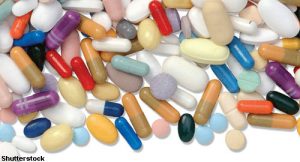 ACR CONVERGENCE 2021—Using pooled data from the TULIP-1 and TULIP-2 clinical trials, researchers set out to identify whether more patients with systemic lupus erythematosus (SLE) being treated with anifrolumab achieved a low disease activity state than patients with SLE who received placebo.1-3 An analysis of the data was presented at ACR Convergence 2021 by Eric Morand, MD, head of the School of Clinical Sciences, Monash University, and director of Rheumatology, Monash Health, Melbourne, Australia.
ACR CONVERGENCE 2021—Using pooled data from the TULIP-1 and TULIP-2 clinical trials, researchers set out to identify whether more patients with systemic lupus erythematosus (SLE) being treated with anifrolumab achieved a low disease activity state than patients with SLE who received placebo.1-3 An analysis of the data was presented at ACR Convergence 2021 by Eric Morand, MD, head of the School of Clinical Sciences, Monash University, and director of Rheumatology, Monash Health, Melbourne, Australia.
Anifrolumab is a type I interferon receptor antagonist.3 On July 30, 2021, the U.S. Food & Drug Administration (FDA) approved anifrolumab for the treatment of adults with moderate to severe SLE who were also receiving standard therapy.4,5 (Note: See below for how this was defined.) The FDA approval was based on both TULIP trials.
The phase 3 TULIP-1 (NCT02446912) and TULIP-2 (NCT02446899) studies were randomized, placebo-controlled, 52-week trials during which 300 mg of intravenous anifrolumab was given every four weeks for 48 weeks to eligible patients with moderate to severe SLE despite standard therapy (i.e., treatment with at least one of the following agents or classes: oral glucocorticoids; antimalarials; and/or immunosuppressive agents, such as methotrexate, azathioprine and/or mycophenolate mofetil).
The study included patients classified as having SLE according to the ACR’s 1997 criteria. All patients were at least 18 years old and had moderate to severe disease, with an SLE Disease Activity Index 2000 (SLEDAI-2K) score of at least 6 points, organ-level involvement based on the British Isles Lupus Assessment Group (BILAG) assessment and a Physician’s Global Assessment (PGA) score of at least 1. During the studies, patients continued their existing SLE therapy at stable doses, except for patients receiving oral glucocorticoids, which were tapered.
The BILAG index is a standardized SLE disease activity assessment. Efficacy in the TULIP trials was demonstrated using the BILAG-based Combined Lupus Assessment (BICLA) response, which includes reducing all severe or moderately severe disease activity, no worsening in other organ systems, no worsening in disease activity, no discontinuation of the trial intervention and no use of restricted medications beyond those allowed in the protocol.
Pooled data for the 300 mg of anifrolumab (n=360) and placebo (n=366) groups were analyzed by time point for achieving a lupus low disease activity state (LLDAS), defined as:
- An SLEDAI-2K score of 4 or less without major organ activity;
- No new disease activity;
- A PGA score (0–3) of 1 or less;
- Prednisone or equivalent glucocorticoid use of less than or equal to 7.5 mg/day; and
- Tolerating standard immunosuppressant dosing.
The time to achieving LLDAS was compared between treatment groups using Cox regression. The cumulative time to LLDAS was compared using a Cochran–Mantel–Haenszel approach, and responses were compared using logistic regression. All P-values are nominal.
The Results
At week 52, 114 patients (13.9%) achieved LLDAS. Of these 114 patients, 102 (89.5%) were also BICLA responders. This analysis also included patients in the TULIP-1 trial who received 150 mg of anifrolumab, as well as a group of patients who received 300 mg of anifrolumab. Of the BICLA responders, 102 of 318 (32%) achieved LLDAS at week 52. More patients achieved LLDAS as the 52-week trial continued, and LLDAS was achieved earlier in the trial by patients treated with 300 mg of anifrolumab than by those treated with placebo.
Also at week 52, 17.5% of patients who received anifrolumab and 10.6% of patients who received placebo achieved LLDAS. Patients who received anifrolumab had more cumulative time (P<0.001) and percentage of time (P<0.001) in LLDAS than patients who received placebo. The cumulative time in LLDAS thresholds of at least 20% (odds ratio [OR] 1.8, 95% confidence interval [CI] 1.2–2.7; P=0.004) and at least 50% (OR 1.9, 95% CI 1.0–3.4; P=0.035) also favored patients treated with anifrolumab.
Patients treated with anifrolumab were more likely to sustain LLDAS for at least three consecutive visits (18.6%) than patients who received placebo (12.5%). Additionally, they were more likely to sustain LLDAS for at least five consecutive visits (11.2%) or at least seven consecutive visits (6.8%) than patients who received placebo (7.7% and 2.7%, respectively).
This analysis of phase 3 clinical data of anifrolumab showed that LLDAS is an attainable treat-to-target end point in lupus clinical trials, and LLDAS is more stringent than BICLA. Treatment with anifrolumab led to earlier, and more frequent and sustained, LLDAS response.
Michele B. Kaufman, PharmD, BCGP, is a freelance medical writer based in New York City and a pharmacist at New York Presbyterian Lower Manhattan Hospital.
References
- Morand E, Abreu G, Furie R, et al. Attainment of the lupus low disease activity state in response to anifrolumab in 2 phase 3 trials [abstract 1459]. Arthritis Rheumatol. 2021 Oct; 73 (suppl 10).
- Efficacy and safety of two doses of anifrolumab compared to placebo in adult subjects with active systemic lupus erythematosus (TULIP-1; NCT02446912). ClinicalTrials.gov. 2019 Dec 5.
- Efficacy and safety of anifrolumab compared to placebo in adult subjects with active systemic lupus erythematosus (TULIP-2; NCT02446899). 2020 Apr 21.
- Highlights of prescribing information: Saphnelo (anifrolumab-fnia) product label. U.S. Food & Drug Administration. 2021 Jul 30.
- BLA approval letter: Saphnelo (anifrolumab-fnia). U.S. Food & Drug Administration. 2021 Jul 30.



